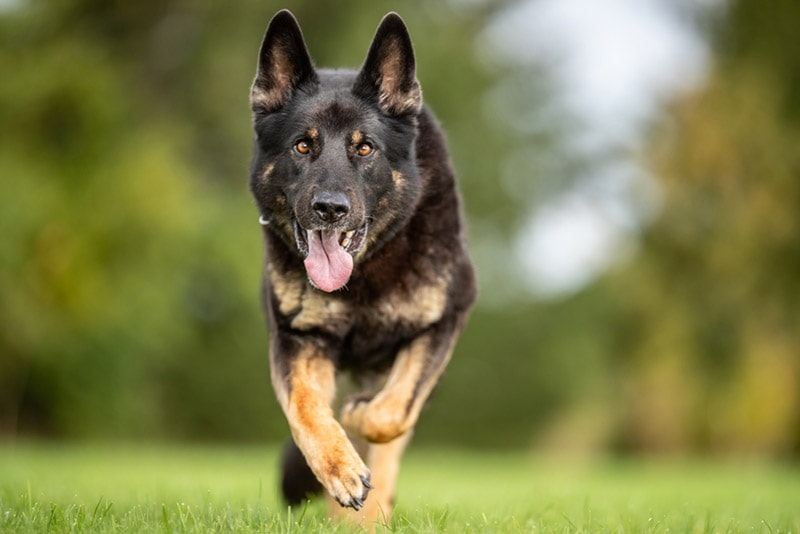How to Train Your Dog to Use a Doggie Door: 8 Vet-Reviewed Steps

Updated on
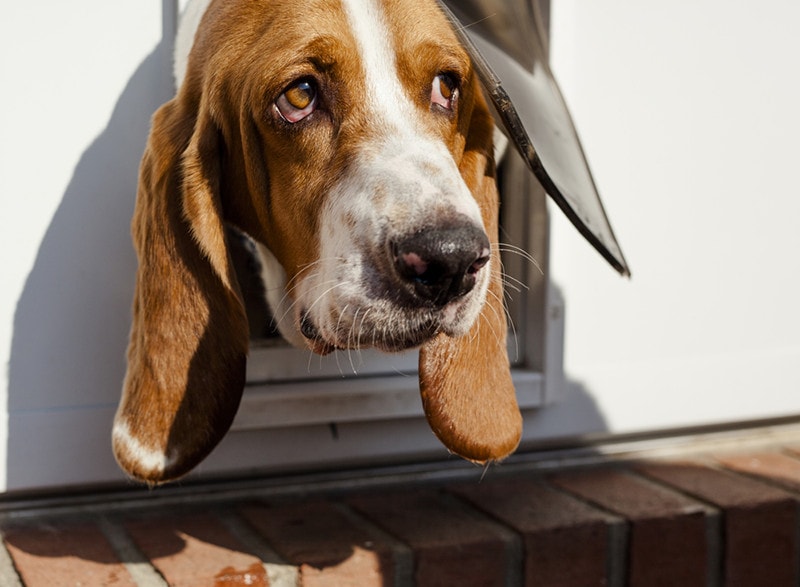
Dog doors are amazing. They cost next to nothing, yet provide our furry buds with quick, easy access in/out of the house. Say, if the pet wants to get some fresh air or stretch their legs, they won’t need your help with that. However, unlike inquisitive cats, most dogs rarely (if ever) notice this “magic gateway”: it’s like they don’t even know it’s there!
The good news is—you can always train the doggo. As long as you are patient and supportive and pack enough treats, you can help the pet see the true value of a doggie flap. So, how do you do that? We’ve got your back! Our experts put together a detailed, step-by-step guide. Check it out!
The 8 Steps for Training a Dog to Use a Doggie Door
1. Introduce the Dog to the Door
First, please make sure the door is the right size for your dog so they don’t get stuck. With dogs, the right introduction is 50% of the success. So, take it slow and start by grabbing the pet’s attention. Once you have it, show the four-legged bud the door and encourage them to come closer with positive reinforcement (praise and treats). Next, push the flap in and out a couple of times with your hands and give the doggo even more treats to keep them interested.
This way, the pet will know that the doggie door is nothing to be afraid of and that they will get extra treats for following your guide. These same “baby steps” are used when introducing the dog to a new crate, bed, or toy or when teaching them a new move/command. The goal here is to create a positive association with the door and the flap.
At any point in these training steps, the doggo might stop or show less enthusiasm, and that’s totally okay. Instead of pushing for results, simply let them catch their breath. Encourage every successful crossing with snacks, toys, and praise. Don’t let the dog’s accomplishments go unnoticed!

2. Let the Pet Interact With It
Alright, now it’s time for the pooch to get up close and personal with it. Be ready to reward the dog with pets and tasty snacks for every bit of interaction, be it sniffing or pawing. If the doggo is pushing the flaps with its nose, that means they are genuinely excited about it. Some dogs are naturally curious about new things, while others are very shy.
So, let the pet play around with the flaps for as long as they needs. Continue to reinforce the dog every time they push the flap. Once they stop being surprised by the mechanism and realizes that it can be controlled, the next stage will be much easier to master. Again, don’t forget to reward them for showing interest and interacting with the flap, but once they have pushed it, that is the new goal, so try to reserve the treats only for forward moves toward the final goal.
3. It’s Time to Go Through!
At this point, the doggo is ready to take a leap of faith and cross the door. To make the job easier for the fur baby, go ahead and open the flap manually (or lock it in the right position). Next, hold up a treat or two in your hand from the other side of the door. The dog should see the treats (or it can be toys) clearly and understand that they need to hop over to get them.
Resist the urge to give the doggolarge-sized treats, as they might lose focus on the task at hand. However, it is a good idea to reward them with a jackpot of many treats the first time they finally go through the flap and end up in the backyard.
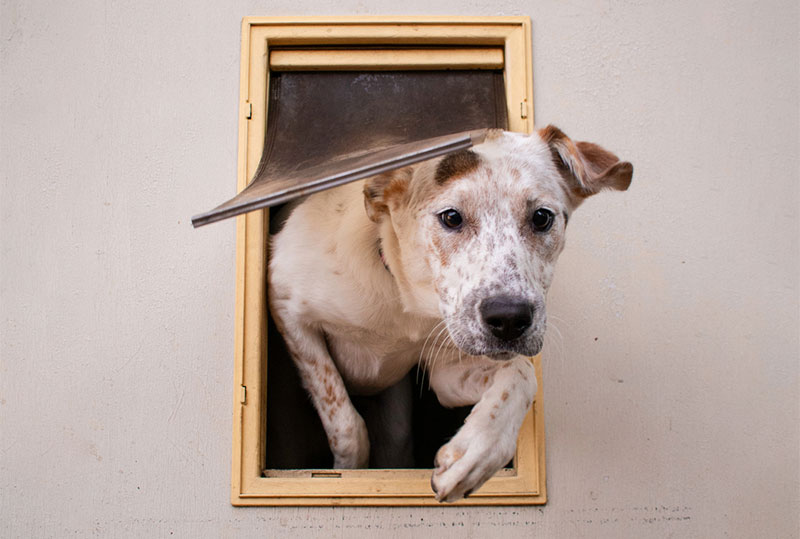
4. Help the Doggo Push the Flap
We’re almost there! All that’s left to do is to teach the dog how to push the flap hard enough to open it up. But before getting to that, practice the going in and out of the house part until the dog doesn’t show any signs of hesitation. Without mastering this part, it will be almost impossible to persuade the dog to operate the flap manually.
While you’re still on the other side of the door (standing on the outside), keep the flap open, but only halfway through. Use the good-old trick of holding treats and toys really close to the dog’s nose to trigger a response. To get the reward, the flurry companion will have to put some effort into it and push the flap, and that’s exactly what we want.
5. Take It a Step Further
Don’t rush the dog; instead, give them time to get familiar with the idea of “fighting” the flap to chew on the treats. Once they are comfortable with that, go ahead and lower the flap. Do this gradually, making the task a bit harder with each pass.
You should make sure the door works well enough that your dog never gets stuck on either side of the door. Getting stuck even once might make the dog uncomfortable and confuse them.
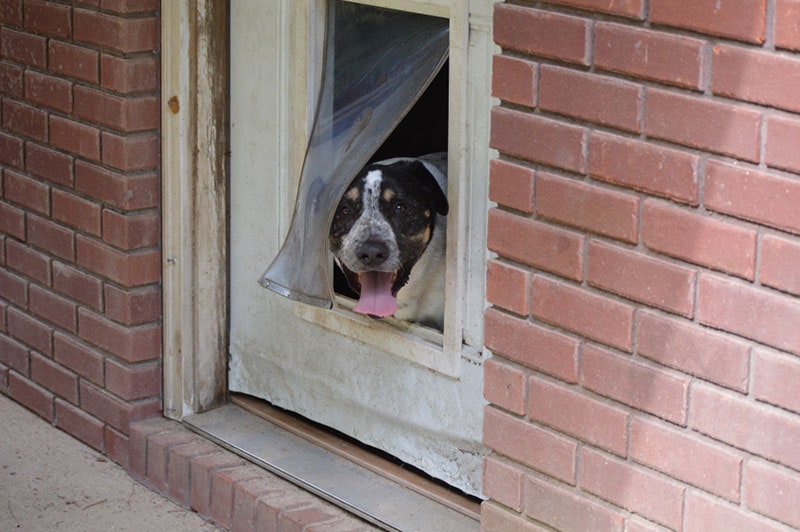
6. Repetition Is the Key to Success
By now, the doggo should be happily hopping in and out as you keep lowering the flap. The idea is to get the pet to do it manually without any help from your side. If you’re the proud owner of a smart and witty doggo with a let’s-get-it-done attitude, they will handle the task with flying colors. If not, you’ll have to stick around for a bit longer.
In any case, next time the dog needs to go outside to do their business, encourage them to use the doggie door. Keep the main door closed, leaving the flap as the only way out. Lastly, come up with a command like “Out” or “Gate” and use it whenever the pet has to go. As you’ve probably already guessed, praise and treats are in order here as well.
7. Keep the Sessions Short
Even the most loyal, eager-to-please, and curious dogs don’t have a long attention span. That’s why it’s recommended to keep the training sessions nice and short. Remember: it’s all about turning the learning process into a game and showing the dog that they can trust you and don’t have anything to worry about. If you demand its full attention for a full hour, most likely, that won’t get you anywhere.

8. Try the Guiding Method Instead
Verbal encouragement and treats work best on a wide range of dogs. It’s when you use tasty snacks and positive reinforcement to help the pet learn and achieve new things. But if your dog follows you everywhere without hesitation, you can try putting the guiding method to good use instead. As long as your furry bud isn’t afraid of the door (and doesn’t weigh a ton), this will work.
Here’s how you do it:
- Put the pet through the doggie door and be very gentle not to hurt them
- Once they are through, give them lots of treats and praise
- Repeat the process for at least 2–3 days to build confidence
- Remember to praise and treat the dog for successful actions
- Keep the sessions very short (up to 5 minutes)
- If they still don’t follow commands, pick the dog up and repeat
- Be patient and consistent, and you’ll get there!
Doggie Doors: Do You Actually Need One?
If you live in an apartment, a dog flap might not be used that often, but in a house with a backyard, a doggie door is a must. When properly trained, the pets will be able to get out on their own and never bother you with a bark, howl, or restless behavior like door dashing. On average, dogs take several toilet breaks per day, and with a pet door, they’ll be able to do their business whenever they please.
Besides, no matter how big of a couch potato your bud is, every dog needs to run around and exercise a bit to stay in shape. And with a doggie door, you won’t have to wake up early in the morning for a stroll with the doggo. People that own more than one pet (and it doesn’t have to be only dogs) will find this “hatch” to be a great investment as it can keep the animals happy while leaving the parents alone.
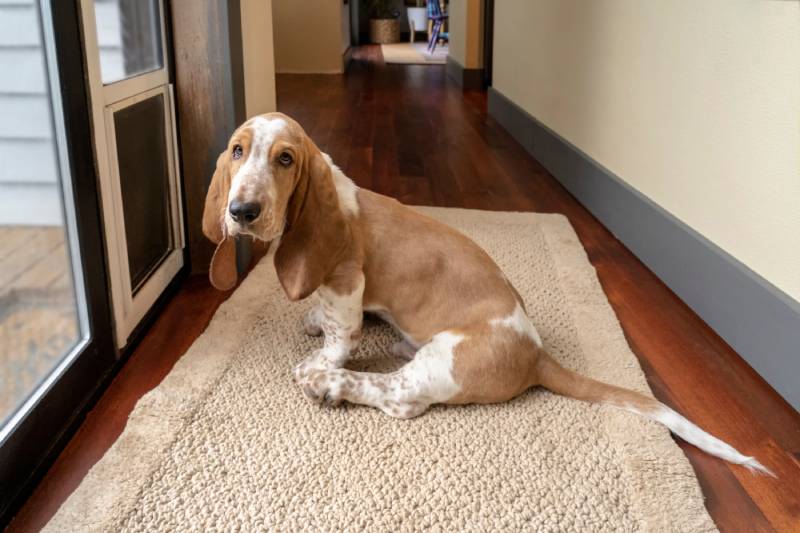
The Downsides of Using Pet Doors
The most significant downside of adding a doggie door is security, or, rather, the lack thereof. Intruders often use these doors for easy access into the house from the backyard. Wild animals also tend to be a problem. To counter this, you can lock the door or install sensors, cameras, and motion detectors to scare burglars and critters away.
Electronically-operated flaps that recognize a microchip in your pet are also an option. Another downside has to do with energy efficiency. A flap that doesn’t close properly will let cold air in, upping your bills. And if the build quality is low, the door might break down and (potentially) hurt the dog. Or the pet will get stuck while trying to go through.
Safety Precautions: Making the Yard Dog-Proof
If the fence is too short, the pet will be able to jump over it and get lost, or worse, get hit by a vehicle. More importantly, if you have little kids in the house, they might follow after the doggo and escape into the great outdoors, potentially harming themselves. And let’s not forget that dogs can dig under the fence (no matter how tall it is). So, you need to put the yard “on lock”.
Also, they should have a crate with a roof or a doghouse where the pet can drink some water and hide from rain or sun rays. With that out of the way, make sure there aren’t any poisonous plants, shrubs, or trees on the property that can harm the pet. Lastly, keep the yard free of pesticides and other chemicals and remove any foreign object that the dog might ingest.
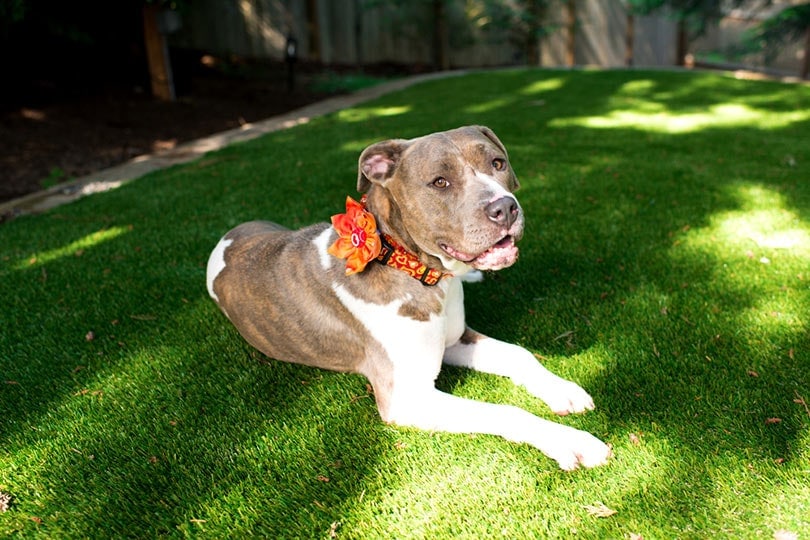
What About the Door’s Size?
Dog doors come in all shapes and sizes, and a flap that fits a small doggo won’t be at all comfortable for a larger breed. The door needs to be spacious enough so that the pet can easily go in and out without having to squeeze through. The dog could get stuck and end up hurting themselves! So, grab a measuring tape and measure the doggo’s height, going from the ground to its back.
To play it safe, add an inch or two. Next, measure their width (at the shoulders) and add an extra 2–3 inches as well. The dog might grow bigger (if they’re still a pup) or put on some weight in the future. And for a big, strong canine, the door should always be a bit larger for added comfort. The same can’t be said about smaller breeds, though, as the heavier flaps will take effort to push open.
 Conclusion
Conclusion
If you have a yard and a dog, a doggie door isa great option. First, it gives the pet freedom, extra mobility, and the ability to get in and out of the house as they please. You, in turn, get peace of mind, serenity, and a more independent, self-sufficient dog. What’s not to like?! Unfortunately, building a flap doesn’t automatically mean the dog will start using it.
Like with many things, it takes some effort to teach/train a four-legged companion how to use it. This isn’t rocket science, of course, but you will have to be persistent and patient. Also, don’t forget to get the right size, implement security measures, and keep the doggo safe!
Featured Image Credit: Dmussman, Shutterstock




